




 goto source
goto source3rd edn addenda, page 230:- "But a couple of hundred yards above this [Gingle Pot] another cavern opens, much more astonishing than the others. The first approach to this presents a perpendicular descent from nearly a level surface, beautifully bordered with trees and shrubs, which nature seems to have meant as a guard as well as beauty. On one side you may descend, by crawling from one broken stratum of rock to another, till you are twenty yards beneath the surface: In the descent one may rest between the projecting parts of the rock, or creep many yards horizontally between them, where we shall find the rocks and stones encrusted with spar, and the cavernous part filled with petrifactions in the shape of shells, moss, icicles, &c. Most of the sparry and roof incrustations, I take to be the fine particles of the limestone dissolved by the rain-water, in its descent through the rocks, which sinking slowly through the roof of these caverns, the water evaporates, and leaves the fine particles of stone to concrete behind; forming hollow conic figures on the roof, or if they fall on the bottom of the cavern, form those knobs of calcarious fossil, which cut off horizontally, are polished into curiously variegated slabs. That the same impregnated waters falling on shells, fish-bones, &c. should in time displace the calcarious matter of which these are naturally formed, and that these stony particles should in time assume the same shape and form the shells, bones, snakes, &c. so commonly found in limestone countries, I cannot say I am so clear in.- May it not be, that nature has ordained, that particles of such and such properties, meeting with a proper nidus in the bowels of the earth, and similar to that in which they may assemble on the outside of an animal, may run into the same forms, and amuse us with the shape of cockles, limpets, snakes, &c. formed in the middle of rocks?"
"But to resume our journey down this amazing cavern.- After descending from ledge to ledge in a retrograde motion, through arches of prodigious rocks, thrown together by the rude but awful hand of nature; at the depth of 70"
 goto source
goto sourcePage 231:- "yards we see a parabolic cascade, rushing from a hole nigh the surface, and falling the whole 70 yards, with a roar, which reverberated by the rocks above, confounds and astonishes the most intrepid ear! The spray arising from this cascade fills the whole cavern, and if the sun happens to shine into it, generates a most vivid and surprising rainbow, Another cascade, of not quite so great a fall, issues perpendicularly from a projecting rock with equal rapidity as the first, and is certainly a part of the same subterraneous brook; they fall together into a narrow pool at the bottom, which measures 37 yards in depth; and proceeding underground about a mile, break out, and form the large brook that runs by Ingleton, and from thence to the river Lune. In the time of great rains, the subterraneous channel that conveys away the water becomes too small, and then the cavern fills to the depth of above 100 yards, and runs over at the surface."
"To a mind capable of being impressed with the grand and sublime of nature, this is a scene that inspires a pleasure chastised by astonishment! Personal safety also insinuates itself into the various feelings, where both the eye and ear are so tremendously assailed.- To see as much water as would turn several mills, rush from a hole near 70 yards above the eye, in such a projectile as shews its subterraneous fall to be very considerable before it enters the cavern; and to see the fine skirting of wood, with various fantastic roots and shrubs, through a spray, enlivened by a perfect rainbow, so far above the eye, and yet within the earth, has something more romantic and awful in it than any thing of the kind in the three kingdoms!"
"Ascending from the dark excavations we found at the bottom of this dreary cavern, we once more bless ourselves in broad day-light, ..."
placename:- Weathercoat Cave
placename:- Weathercoat Cove
 goto source
goto sourceTour to the Caves in the West Riding of Yorkshire, late 18th century
Page 258:- "..."
"Returning back a little way from Ginglepot, in order to find a passage out of this dreary glen, we proceeded about an hundred and twenty yards higher, when we came to Weathercoat cave, or cove [1], the most surprising natural curiosity of the kind in the island of Great Britain. It is a stupendous subterranean cataract, in a huge cave, the top of which is on the same level with the adjoining lands. On our approach to its brink, our ears and eyes were equally astonished with the sublime and terrible. The margin was surrounded with trees and shrubs, the foliage of which was of various shapes and colours, which had an excellent effect both in guarding and ornamenting the steep and rugged precipices on every side.- Where the eye could penetrate through the leaves and branches, there was room for the imagination to conceive this cavern more dreadful and horrible, if possible, than it was in reality. This cave is of a lozenge form, and divided into two by a rugged and grotesque arch of limestone rock: the whole length, from south to north, is about sixty yards, and the breadth about half its length. At the south end is the entrance down into the little cave; on the right of which is a subterranean passage under the rocks, and a petrifying well. A stranger cannot but take notice of a natural seat and table in a corner of this grotesque room, well suited for a poet or philosopher: here he may be secluded from the bustle of the world, though not from noise; the uniform roaring, however, of the cascade, will exclude from the ear every other sound, and his"
"[1] The word cave is pronounced by the country people cove, or coave. This hint may be of service to a stranger in his enquiries.- This cave is not above 100 yards from the turnpike-road from Lancaster to Richmond: it is on the left hand side of the twenty-second milestone from Lancaster, from whence the cascade may be distinctly heard. The delicate and timid may neither be afraid of their persons or clothes, if they have no mind to descend: they may stand safe on the margin of either Hurtlepot, Ginglepot, or Weathercoat-cave. They will there see enough to astonish them, and imagination will supply the rest."
 goto source
goto sourcePage 259:- "retirement will conceal him from every object that might divert the eye.- Having descended with caution from rock to rock, we passed under the arch, and came into the great cave, where we stood some time in silent astonishment to view the amazing cascade. The perpendicular height of the north corner of this cave, was found, by an exact admeasurement, to be thirty-six yards. Near eleven yards from the top issues a torrent, out of a hole in the rock, about the dimensions of a large door in a church, conveying usually as much water as the New River at London. It rushes forwards with a curvature, which shows that it has had a steep descent before it appears in open day, and tumbles precipitately twenty-five yards perpendicular down on the rocks at the bottom, with a noise that amazes the most intrepid ear. The water sinks as its (sic) falls amongst the rocks and pebbles, running by a subterranean passage about a mile, when it appears again by the side of the turnpike road, visiting in its way the other caverns of Ginglepot and Hurtlepot. The cave is filled with the spray that arises from the water dashing against the bottom; and the sun happening to shine very bright, we had a small vivid rainbow within a few yards of us, for colour, size, and situation perhaps no where else to be equalled. A huge rock, that had sometime been rolled down by the impetuosity of the stream, and was suspended between us and the top of the cascade, like the coffin of Mahomet at Medina, had an excellent effect in the scene. Though the stream had polished the surfaces of the pebbles on which it fell at the bottom, by rolling them against each other, yet its whole force was not able to drive from its native place the long black moss that firmly adhered to the large immovable rocks. We were tempted to descend into a dark chamber at the very bottom of the cave, covered over with a ceiling of rock above 30 yards thick, and from thence behind the cascade, at the expense of having our clothes a little wet and dirtied; when the noise became tremendous, and the idea for personal safety awful and alarming, as the rocks on which we stood, and every one about us seemed to shake with the vast concussion. We were informed, that in a great drought the divergency of the stream is so small, that we might with safety go quite round the cascade. At"
 goto source
goto sourcePage 260:- "the bottom we were shown a crevice, where we might descend to the subterranean channel, which would lead us to Ginglepot, and perhaps much farther: we were also shown above a shallow passage between the strata of rocks, along which we might crawl to the orifice out of which the cascade issued, where it was high enough to walk erect, and where we might have the honour of making the first expedition for discoveries, no creature having yet proceeded in that passage out of sight of day-light: but as we were apprehensive the dangers and difficulties to be encountered in our progress, would not be compensated by the pleasure, we did not attempt to explore these new regions [1]. After a little rain another cascade, similar to the former, falls nearly from the same height on the west side of the cave, appearing and disappearing, with great variety, amongst the rocks, as if it fell down the chimney of a ruinous building, where several holes were made into it in the gable end. If the rains still increase, a large stream sets in out of the room by the side of the little cave; and in great floods, a vast river falls into the great cave, down the precipice on the eastern side. Nothing can be more grotesque and terrible, than to view this cave when about half full of water: a variety of cascades issue from crannies in every quarter - some as small as a tap in a hogshead, and others as copious as rivers - all pouring with impetuosity into this deep and rugged bason. With their united streams they are sometimes able to fill the whole capacity of the cavern, and make it overflow; the subterranean crannies and passages of this leaky vessel not being able, with the increased pressure from above, to carry off the water as fast as it is poured"
"[1] The writer of this Tour, in company with the owner of the cave, and some others, has since been in the passage out of which the cascade issues, but is not able to tell how far it extends, as it was high and wide enough to admit passengers much farther than they were. The owner of the cave, and others, have been in the passage beneath, half way to Ginglepot: they have no doubt but it leads thither: they did not get so far, owing to the water deepening, more than the height lessening. Another subterranean river, that from Gatekirk above, meets this cascade directly underneath it, along which there is a passage, and which the above party, in some measure through mistake, explored, having missed their way in their return, and gone far beyond the cascade, before they were convinced of their error by the noise of the cascade gradually decreasing."
 goto source
goto sourcePage 261:- "in: but this happens only about six or seven times in twenty years [1]."
"Having satisfied our curiosity in viewing this wonder of nature, and moralized on the insignificancy of all human attempts in producing any thing like it, we ascended into our native regions, and proceeded to another, called Douk-Cove, about a mile south, ..."
 goto source
goto sourcePage 269:- "... The brook which runs through this cave [Gatekirk] is the main stream of the river Greta, which runs under ground for at last two miles, making its appearance here, at Weathercoat, and a few other places in its way down to its open channel."
placename:- Weathercote Cave
page 5:- "..."
"FOUR VIEWS OF WEATHERCOTE CAVE."
"THIS Cave is about four miles from Ingleton, on the Hawes road, in a valley, called, Chapel in the Dale, between the mountains Whernside and Ingleborough. The general appearance of the country does not indicate any thing uncommon; great surprise is therefore occasioned on coming so unexpectedly upon this extraordinary spot."
"TREES ABOVE WEATHERCOTE CAVE, INGLEBOROUGH IN THE DISTANCE. --- The Cave is under a clump of trees which stand near the foreground of this view: the trees are enclosed by a low stone wall, on the other side of which is a door. On entering, you immediately descend between bold irregular rocks, overhung with trees and shrubs, which give the scene a wild and picturesque character."
"WATERFALL IN WEATHERCOTE CAVE. --- Descending about twenty yards, you pass under a great mass of rock, crossing the path to the waterfall, which is now heard dashing with great violence, and is seen, after getting from under this rock, gushing out of a cave in the precipice before"
WTL2p06.txt
page 6:- "you, and passing beneath the rocks on which you stand. One of the most striking features of this scene is an immense stone hanging before the cave, and appearing to be but very slightly supported by the projecting rocks. From this spot, between eleven and two o'clock, when the sun shines, a most beautiful effect is observable, by the prismatic colours forming like a rainbow in the spray of the waterfall. The descent from this place, although difficult, owing to the ruggedness of the rocks, repays the traveller for his trouble, as the scene between the waterfall and the precipice is very interesting. The spectator may stand in perfect safety with the water falling above and dashing close to his feet, where it immediately passes into a cleft in the rocks, and continues its way under ground for nearly a mile."
"WEATHERCOTE CAVE, LOOKING FROM THE WATERFALL. -- This view is taken from under the rock that crosses the path to the waterfall, looking towards the entrance."
"WEATHERCOTE CAVE, FROM THE SOUTH SIDE. --- This view looks down upon the waterfall, with the other objects before described."
placename:- Weathercote Cave
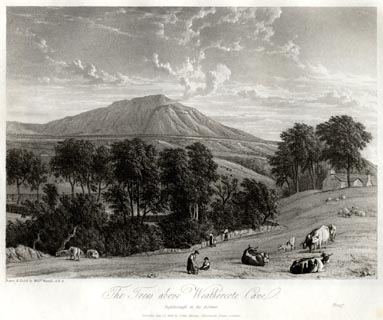 click to enlarge
click to enlargeWTL205.jpg
"Drawn & Etch'd by Willm. Westall A.R.A. / The Trees above Weathercote Cave. / Ingleborough in the distance. / Publish'd July 12. 1818. by John Murray, Albemarle Street, London. / Proof"
item:- print
Armitt Library : A6670.5
Image © see bottom of page
placename:- Weathercote Cave
 click to enlarge
click to enlargeWTL206.jpg
"Drawn & Etch'd by Willm. Westall A.R.A. / Waterfall in Weathercote Cave. / Publish'd July 12. 1818. by John Murray, Albemarle Street, London. / Proof"
item:- print
Armitt Library : A6670.6
Image © see bottom of page
placename:- Weathercote Cave
 click to enlarge
click to enlargeWTL207.jpg
"Drawn & Etch'd by Willm. Westall A.R.A. / Weathercote Cave, / looking from the Waterfall. / Publish'd July 12. 1818. by John Murray, Albemarle Street, London. / Proof"
item:- Armitt Library : A6670.7
Image © see bottom of page
placename:- Weathercote Cave
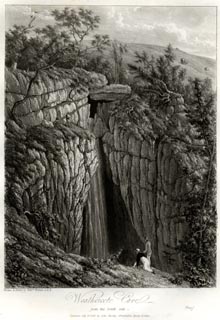 click to enlarge
click to enlargeWTL208.jpg
"Drawn & Etch'd by Willm. Westall A.R.A. / Weathercote Cave, / from the South side. / Publish'd July 12. 1818. by John Murray, Albemarle Street, London. / Proof"
item:- Armitt Library : A6670.8
Image © see bottom of page
placename:- Weathercote Cave
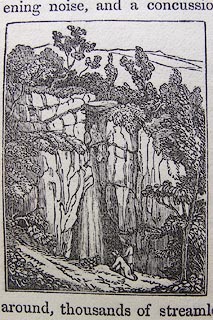 click to enlarge
click to enlargeO80E52.jpg
Weathercoate Cave
 goto source
goto sourcePage 197:- "..."
"WEATHERCOTE CAVE.- This surprising natural curiosity is of a lozenge form; and its whole length, from north to south, is about 60 yards. It is divided into two parts by a rugged arch of limestone. The entrance is"
 goto source
goto sourcePage 198:- "by a door in the south-east side, and you proceed down a flight of rude steps, under the arch, into the great cave. Here you full in view of the cascade which rushes out of a hole in the north corner of the gloomy cavity. Rocks covered with black moss, rise to the height of 120 feet; and the trees, meeting nearly over the top, add to the gloom and horror of the place. The cascade, however, absorbs all the attention. The exact height of the north corner of the cave is 40 yards, and the aperture whence the water issues is 11 yards from the top, the fall making a clear leap of 29 yards, or 87 feet, upon a large flat rock at the bottom, with a deafening noise, and a concussion which makes the earth seem to tremble. Between the spectator and the cascade is a fragement of rock, suspended by its opposite angles touching the sides of the crevice. When the sun shines, a small, but vivid rainbow is formed in the thick spray, which continues about two hours at mid-day. After heavy rains the water pours into this cave on all sides. All around, thousands of streamlets, some as small as"
 goto source
goto sourcePage 199:- "running of a tap, others copious as a mill-race, hurl themselves into the boiling cavity, which, unable to carry off the deluge, is sometimes full, and flows over its bounds."
item:- Armitt Library : A1180.41
Image © see bottom of page
placename:- Weathercote Cave
 goto source
goto sourcePage 198:-
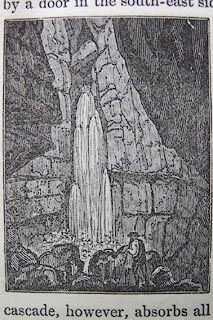 click to enlarge
click to enlargeO80E51.jpg
Weathercoate Cave
item:- Armitt Library : A1180.40
Image © see bottom of page
 click to enlarge
click to enlargeO80E52.jpg
item:- Armitt Library : A1180.41
Image © see bottom of page
placename:- Weathercote Cave
placename:- Mahomet's Coffin
 goto source
goto sourcepage 34:- "WEATHERCOTE Cave, in the valley of the Doe, and four miles from Ingleton, is a wonderful spot. As a mere cave it is, perhaps, not of much note, but as a stupendous chasm into which a magnificent spout of water descends to a great depth, it has, perhaps, no rival in England, unless it be Gaping Gill Hole, the wonders of which are practically inaccessible. Weathercote belongs to Mr. Metcalfe, of Chapel-le-Dale, whose house is very conveniently situated, close to the abyss, and this gentleman admits visitors at the cost of one shilling per head, at the same time supplying a guide, who very courteously gives a considerable amount of interesting information regarding the place."
"After having passed within the enclosing walls, the descent to the cavern is made down a tremendous flight of fifty-one rugged steps, which look as though they were leading into the mouth of the infernal realms. This darksome stair shortly brings one under a prodigious roof of"
 goto source
goto sourcepage 35:- "rock, the descent being still continued over a more rugged way than heretofore. Much to the pedestrian's surprise daylight is seen ahead; the rocks, though towering up in front and on either hand, do not meet above, and instead of having, as yet, entered the bowels of the earth, the foot has only passed below a gigantic block of natural masonry. In front huge stones are rankly scattered down a steep incline that loses itself in a dark nook below. The rock immediately opposite is one hundred and eight feet high; thirty-one feet below is a gap in the corner of the rocks, whence a spout of water rushes with great force from behind a huge mass of rock, wedged in between the opposite cliffs, and then, descending from higher recesses of the upper cavern for ten feet, is precipitated to a further depth of sixty-five ere crashing into the small but turbulent basin beneath. When the sun is shining at mid-day in summer, a splendid rainbow arch spans the ascending spray, which bedews the mossy rocks so thickly with its glittering drops. When the water is low the inquisitive tourist may descend, amid a misty shower, and pass to the back of the fall to look up to daylight through the falling waters that sink at once into the hole to which they are precipitated. There is a low cave, of no great interest, at the southern side behind the cataract, which, in time of flood, has to form an exit for the excess of water that the usual passage is unable to convey. After unusually heavy rains various cascades pour over the edges of the rocks, and through a rift, into the abyss or whirlpool-hole below, for then the cave becomes half filled with water, and occasionally the river, descending the dry watercourse to the north-east - the course for the top water in heavy floods - pours as a muddy torrent over the verge of the flanking rock, filling the cavern to the brim with its liquid superfluity, and overflowing through the gaps in the wall forming the southern boundary."
 goto source
goto sourcepage 36:- "Once more returning to the upper world we climb, or rather cautiously proceed, to the top of the great bridge of rock from under which we so recently emerged. Thence can be seen the wonders of the depths beyond, where, but a few moments since, the gazer was immured. Springing around from turf and stones beneath the overshadowing trees, several plants of interest are descried growing in nature's wildness - the London pride, some smaller species of geranium, and others, that help to form a strange and pleasing contrast with the weird scene so lately left and still confronting us with the huge stone, called Mahomet's Coffin, caught up in mid-air before the tunnel whence the Doe bursts forth."
placename:- Weathercote Cave
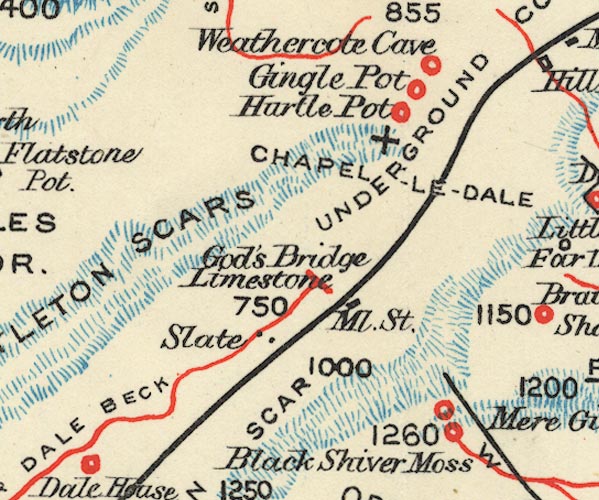
BS1SD77I.jpg
"Weathercote Cave"
item:- private collection : 27.1
Image © see bottom of page
